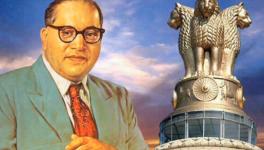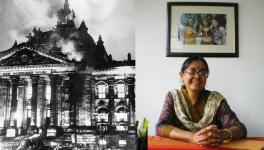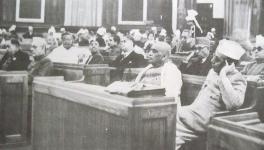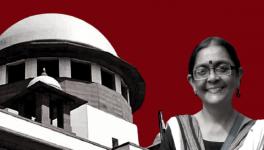Why Panvel, a Hub of Dance Bars, Doesn’t Want Chham Chham
Image for representational use only; Image Courtesy : India Rail Info
Chham Chham is a sound associated with anklets. Nobody knows who actually named the dance bars as Chham Chham, but once can guess that long time ago, before the dance bars came into existence, there were places where women used to perform Mujra (a dance performed by courtesans), who used to wear ghungroos (anklets) with little bells. Though the Maharashtra’s bar dancers never wore ghungroos, the stamp of Mujras stuck forever with these places.
"You know what, there were so many dance bars in Panvel that we used to call it Chham Chham capital", senior Maharashtra police officer told Newsclick, requesting anonymity. But yes, that was the image of Panvel way back in 2005 ,and before.
How the Issue Became Mainstream
In monsoon session of 2005, Vivekanand Patil , a Peasant and Workers' Party' (PWP) leader and a Member of Legislative Assembly, proposed a discussion on a 'calling attention' motion on rising crimes due to dance bars in Panvel and surrounding areas. He was an MLA representing Panvel. While answering on the subject, then Deputy Chief Minister and Home Mbinister of Maharashtra, RR Patil, announced a complete ban on dance ars in Maharashtra, adding that the bars were becoming one of the reasons for the “cultural and mortal deterioration” of society. This was a huge decision, given the complexity of the issue.
When Patil made this announcement, around 700 bars were operational in Maharashtra, with 300 in Mumbai alone. Later, the Dance Bar Workers Association claimed that 70,000 girls were employed in these bars, which dance as well as serving the customer on tables. That one announcement of banning dance bars by the state government had left the families of one lakh people in dark, it was then said.
How Panvel Became the Nucleus
Panvel is a small town on the periphery of Mumbai inhabited by labourers, farmers and and members of the Aagri, mainly fisherfolk, community. People from Panvel travel every day to Mumbai and Thane for livelihood. In 1983, the first ladies bar, named Shalimar, opened in the city's Tapal Naka (Post Office Square) area. It attracted a huge crowd in Panvel and the adjoining areas of Belapur, Kharghar.
The sudden popularity of dance bars (infamously known as ‘dance bar culture’) picked up in the late 1990s. There are many reasons for this.
As Mumbai was flooded by people, the state government decided to have a second Mumbai nearby. Today's Navi Mumbai (earlier there were many villages, such as Taloja to Ghansoli to Rabale. Now the municipal corporation is being called Navi Mumbai) was just across the creek. It was decided in the 1980s that this area would be the second Mumbai.
This skyrocketed the prices of the otherwise ignored land around the creek. Local people. mainly from the Aagri community, became landlords, thanks to inherited land. Then came the real estate boom along with the planning of a new city. As a result, huge money started flowing into the hands of locals in Navi Mumbai.
Panvel is situated close to Navi Mumbai. So, the wealth that had reached Navi Mumbai also started flowing into Panvel. This was around 1995-96. Till now, this city had only a few dance bars. Soon, Mujra was off the floor and 'disco' dance was in great demand. People from Navi Mumbai started visiting Panvel, as word spread fast.
But this was not the only reason. Panvel's geographic position helped the city in major ways. In 1996, the then Shiv Sena-Bharatiya Janata Party government announced India's first expressway between Mumbai and Pune. The starting point of this expressway from the Mumbai side was close to Panvel. This was a power booster to the already growing city of Panvel.
The expressway was completed in 1999. Now Mumbai-Pune was just three hours distance from the earlier six to eight hours. Post-globalisation growth also started showing its effects in Pune and surrounding areas. Pune became the hub of the IT and automobile industry. The story of Navi Mumbai saw a repeat in Pune's adjoining areas. As a result, land rates shot up in Pimpri, Chinchwad, Chakan and Mulachi, putting a lot of money in the hands of the local inhabitants there too. As has always been the case in the real estate business, people were getting loads of cash in hand. And, for obvious reasons, several people from these areas too started making a beeline for Panvel.
"People from Pune, Pimpri, Ahmednagar, even up to Satara, Mahad and Vasai, used to come to bars in the evening. Rat ko 8 baje aate thhe aur subah 3-4 baje wapis jane ko nikalte the (They used to arrive at 8 p.m and leave the next morning at around 3-4 a.m). The business hours were 7 p.m to 5 a.m in many of our bars," said a bar owner, requesting anonymity.
Panvel – Then & Now
"I remember, many of my friends fustrated after being rejected for marriage because of the image of our village 'Kon' for having so many dance bars. Parents were concerned about the safety and image of their," said Nandu Shisave, Sarpanch of Kon village, which is the adjoining village to Panvel on the old Mumbai-Pune highway.
Kon village alone had almost 45 dance bars on both sides of the highway. After the new expressway came up, the old highway was deserted by all. So, to hide from public glare, the bars shifted into this small village. But they were still known as Panvel bars.
Villagers still recount those “horrible” days.
"People from Pune, Satara, Ahmednagar, Solapur used to come here around 8 to 10 in night. There was so much noise of DJs, orchestra and all. Not just that, many of our villagers had accidents as drunk drivers from outside rammed into them," said Bhushan Patil, a youth from Kon. When asked what he thought of the SC's recent order, he said, "We are scared of old days. We fear, those will return now."
That's why Panvel Sangharsh Samiti, a citizen’s forum, has decided to file writ petition in the Supreme Court. "We will request the court to form a committee for public hearing in Panvel. This SC-monitored committee could visit Panvel and neighbouring villages to get a sense of law and order, peace, cultural issues, so that the SC can rethink its decision," said Kantilal Kadu, head of the forum.
On the SC’s observations about the state government's overrun on the “moral aspect” of bar dancers, Kadu blamed it on government itself. "The state government purposely lost this case. The corrupt machinery -- from the police to politicians -- had vested interests in dance bars. It’s a business that completely ran on cash. So one can understand the interest of this nexus," he said.
Employment for Bar Dancers
This was centre of argument for pro-dance bar people in court. Up to one lakh people were employed by this business, which was always cited by Bar Dancers Association, who questioned the future of these girls if the bars shut down.
The apex court has asked the state government to frame the guidelines for people working in dance bars, urging it to ensure that the wages of these girls remain in sync with the labour Act. This has come as a big relief to many dancers and waitresses.
But the Panvel citizen’s forum is planning to challenge this aspect also. "Every bar or hotel owner has to give in writing about the number of women working in his establishment. So, the government already has the data of the exact number of women. This is not be more than 5,000-7,000. We will request the SC to adjust these girls according to their education in a number of institutions. This would end the debate over employment in dance bars," said Kadu.
He also taunted that the BJP government, which had claimed that it would create two crore jobs. For not being able to “adjust” a few hundred jobs for these girls. "Make in India shall have place for these girls instead of asking them to dance before people. That would be real cultural development," he added.
Conflict of Interest?
The citizen’s forum is strongly opposing the SC’s decision to allow re-opening of bars, but that not the complete picture, too. When asked, Sarpanch Nandu Shisave of Kon village that why all the villagers were uniting on the issue, he kept silent.
Some people from Panel said the huge money involved in dance bars was the main reason that some villagers were also siding with them. Newsclick tried to speak some people on record, in vain. "See, though these bars are not managed by local people, the locations are owned by them. They get huge money as rent. Why would they turn down that money?" said a villager in Kon.
"Suppose a 2,000-square feet place is given om rent to a bank, the owner gets around Rs 1 lakh per month. But, if the same place is given for dance bars, the owner gets Rs 3-4 lakh," said another villager who unofficially deals in the brokering business in Panvel.
"You know, people in the bar business have big connections. We are small people. We tried to fight as per our capacity. Now, it is good to keep quiet and see what’s happening," said Shisave.
His comment summed up the reality of the so-called 'glittering' world of Chham Chham. People don't want it in their area, but after losing the battle in the Supreme Court, very few have the courage to say so.
Get the latest reports & analysis with people's perspective on Protests, movements & deep analytical videos, discussions of the current affairs in your Telegram app. Subscribe to NewsClick's Telegram channel & get Real-Time updates on stories, as they get published on our website.
























